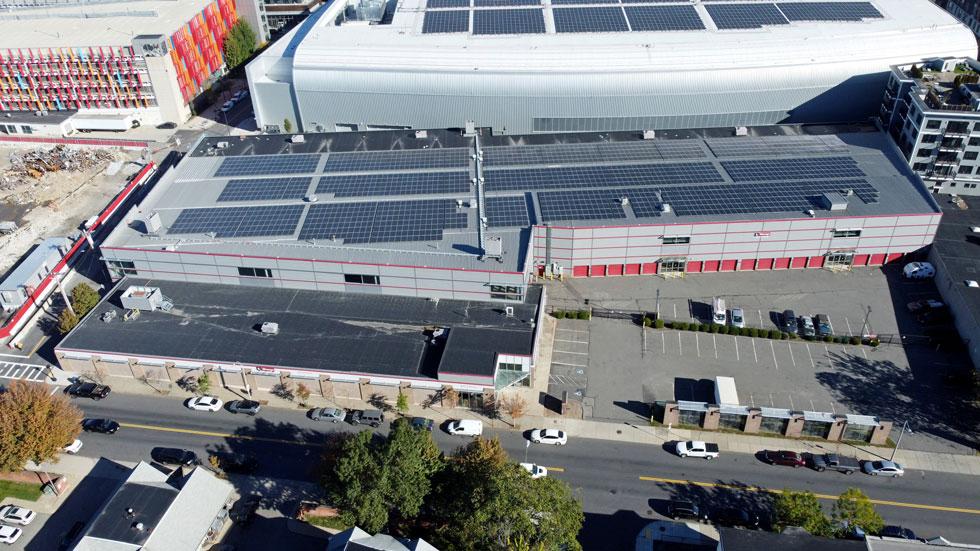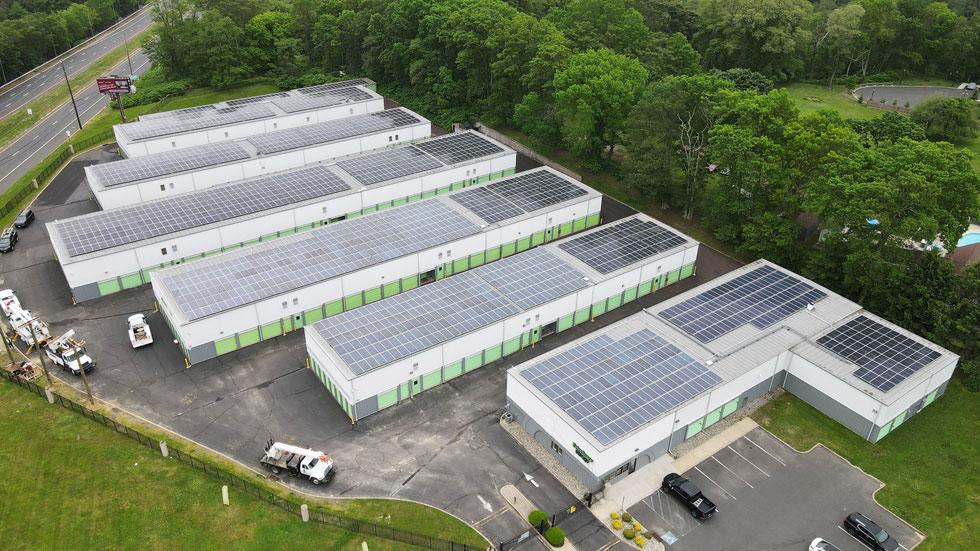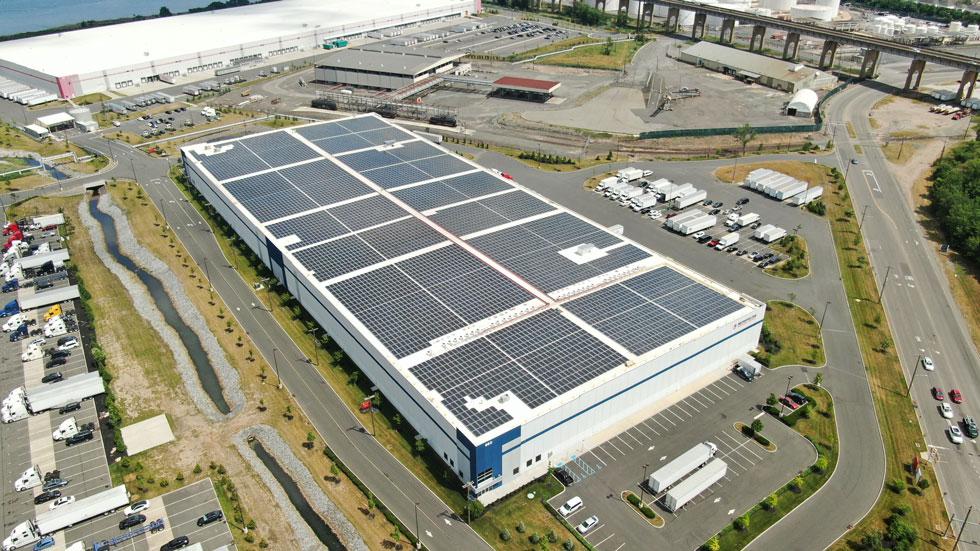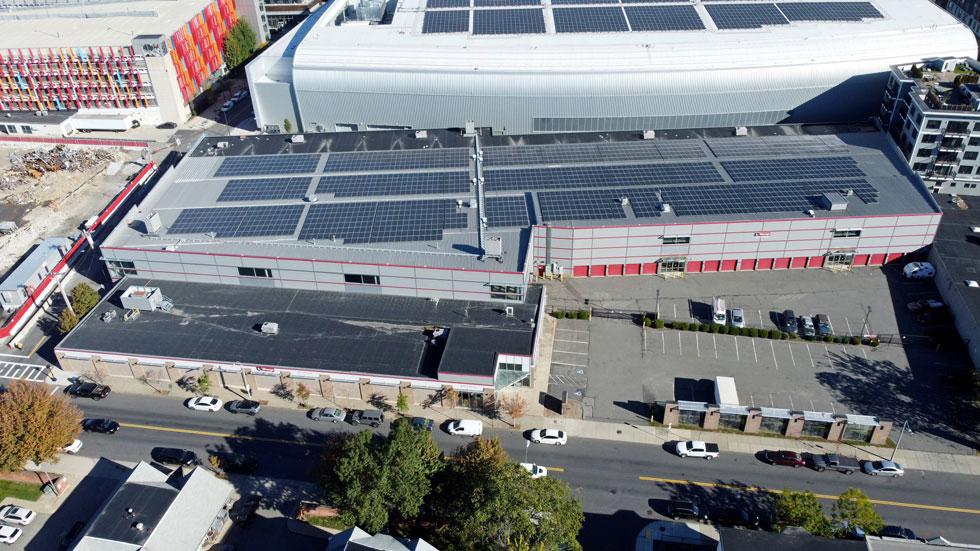
When solar panels began appearing on commercial building rooftops with more frequency early this century, anyone who observed the installations rightly deducted that they were providing power to the underlying property. Today, those panels are increasingly supplying clean energy to surrounding neighborhoods.
The practice, known as community solar, is not only monetizing underutilized space, but it is also helping commercial property owners meet sustainability goals while fostering community connections. Self-storage, industrial, shopping center and other REITs with sizable roof footprints are particularly well-positioned to take advantage of the growing trend.
Under a typical arrangement, solar project developers lease roof space and take care of the rest—the financing, ownership, and maintenance of the photovoltaic installations, as well as plugging into the grid and signing up customers to buy the electricity. This so-called “in-front-of-the-meter” model represents a significant shift away from providing power for on-site use “behind the meter.”
In one of the most recent deals, National Storage Affiliates Trust (NYSE: NSA) in August announced that Solar Landscape would develop at least 100 megawatts of solar capacity across 8.5 million square feet of rooftop space to power homes in a number of states. The companies evaluated the potential of a venture for two years in conjunction with Solar Landscape leasing six initial NSA rooftops in Illinois and New Jersey.
“This is a great ancillary revenue opportunity for us, and one in which we don’t have to make any capital investment and requires minimal time and effort,” says Will Cowan, executive vice president and chief strategy officer for NSA, a REIT based in Greenwood Village, Colorado that owns 68.8 million square feet in 42 states and Puerto Rico. “Ten years ago, I would have said it wouldn’t have been this easy.”
Rooftop Renter
For Solar Landscape, the agreement with NSA continues a bonanza of deals with commercial real estate owners, including REITs such as Prologis, Inc. (NYSE: PLD), Extra Space Storage Inc. (NYSE: EXR), CubeSmart (NYSE: CUBE), and Brixmor Property Group Inc. (NYSE: BRX). Based in Asbury Park, New Jersey, the 12-year-old company initially began as a solar installation subcontractor and evolved into a turnkey developer and long-term asset owner of community solar systems, says Shaun Keegan, Solar Landscape’s co-founder and CEO.
To date, the company leases more than 150 million square feet of commercial roofs nationwide to generate some 1.5 gigawatts of power to more than 262,000 households. “For most landlords, we’re just another tenant that happens to take space on the rooftop,” adds Keegan, who pegs the company’s rooftop capital expenditures at around $3.75 billion. “That’s the evolution of solar power, and business has picked up like crazy.”

Among other projects, in 2021, a Solar Landscape and Prologis partnership began providing 2.67 megawatts to more than 400 residential customers in Perth Amboy, New Jersey. Public Storage last year launched an effort with the company to power more than 10,000 homes in Maryland, New Jersey, and Illinois. And Extra Space and Solar Landscape are delivering 6.5 megawatts to some 1,400 residents in 10 New Jersey communities, including Neptune, Egg Harbor, Old Bridge, and others.
In many cases, low and moderate-income households make up a good portion of the customers. In Perth Amboy, half of the subscribers fall into the group and are seeing up to a 20% savings on energy bills, according to the U.S. Department of Energy.
While the clean energy benefits are undeniable, solar power comes with challenges. Solar panels last about 25 years, and although recyclers have begun to emerge, discarded panels may end up in landfills. In addition to overcast skies and darkness, geography affects the performance of the photovoltaic systems: a system in Southern California will produce about 30% more power than one in Minnesota, Keegan says.

Grid conditions, along with state and utility regulations, can also be limiting factors. In some cases, the grid is too congested to plug into at certain points, he notes. Additionally, only a handful of states have community solar programs and offer tax credits or other incentives to make them work. But momentum is building, he reports.
“More states are realizing that the best policy is to deploy solar on rooftops,” Keegan says. “They’re saying, ‘Let’s let landlords do what they do best and take rent, let’s let companies like Solar Landscape do what they do best and own energy assets, and let’s let the grid do what it does best, which is absorb that energy and deliver it to the community.”
On-Site Energy Converts
Over 15 years, Extra Space installed solar panels on about 55% of its 67 million-square-foot portfolio to provide its buildings with power, but that dropped to 33% after the REIT expanded its footprint to nearly 110 million square feet last year with the acquisition of Life Storage.
Because self-storage assets don’t consume a huge amount of energy, providing on-site generated energy does not span the entire roof. Therefore, the properties can also be utilized to provide community solar projects, says McKall Morris, communications and sustainability manager with Extra Space.
“We’re evaluating our assets with the plan to continue our strategy of putting up enough panels to power our properties,” she says. “But we like the community solar concept, and we’ll continue to look at those opportunities.”
Solar Landscape typically leases rooftop space for 25 cents to 85 cents per square foot per year for 20 years and invests about $20 per square foot in the systems, Keegan says. It also is exploring new structures such as giving property owners an equity stake in the projects or the opportunity to buy the tax credits associated with the deals.

REITs, meanwhile, can participate in community solar not only through roof lease agreements. For example, Prologis is developing community solar projects for a fee. That’s because the REIT now prefers to own the installations and collect the revenue they generate as part of a goal to become one of the largest distributors of clean energy in the world by leveraging its 1.2 billion-square-foot international portfolio, says Vibhu Kaushik, global head of utilities and energy storage with Prologis.
After introducing solar panels to its roofs in 2007 to provide energy to its tenants, Prologis expanded into community solar in 2021 and established a separate clean energy division a year later. The ability to generate power is critical given the amount of energy warehouses will consume as logistics tenants continue to adopt robotics, automated electric forklifts, and other power-hungry technologies, Kaushik explains. The buildings will also serve as charging points for electric trucks.
“Investing in on-site clean energy to decarbonize our buildings has become a core offering that differentiates our real estate portfolio,” he adds. “Our customers see direct benefits.”
Market Adjustments
Communities are benefitting, too. Prologis is using its rooftops to deliver power to neighborhoods in New York, Illinois, and California. In California, the REIT typically contracts directly with the local utility to take the power, but in other states, where community solar providers sign up their customers, it makes sense to partner with third parties, Kaushik explains.
“Every state has its own rules, and some states have multiple community solar programs,” he continues. “In New Jersey, Solar Landscape has the community relationships and subscription management crews. That adds a lot of value when the alternative is to hire 50 people to do the program.”
The clean energy investment and ownership model fashioned by Prologis may not be ideal for all REITs. Brixmor, an owner of some 360 shopping centers across the country, determined that leasing its rooftops to third-party solar developers was a better option given the potential complications of accounting for revenue derived from energy production, says Haig Buchakjian, chief transformation officer.
Brixmor began leasing its rooftops in California several years ago to renewable energy developer Blue Sky Utility, which would then sell the power to the property tenants at a discounted rate, he says. Over time, Brixmor has expanded its efforts to be a conduit for clean energy by pursuing community solar programs. In addition to partnering with Solar Landscape in New Jersey, the company participated in a program to power homes on Long Island, New York, and it is working on community solar projects in Connecticut and Massachusetts.
“These programs are a way to monetize space that would otherwise not be generating revenue,” Buchakjian says. “At the same time, it helps our sustainability goals as we try to reduce or offset our greenhouse gas emissions footprint.”



